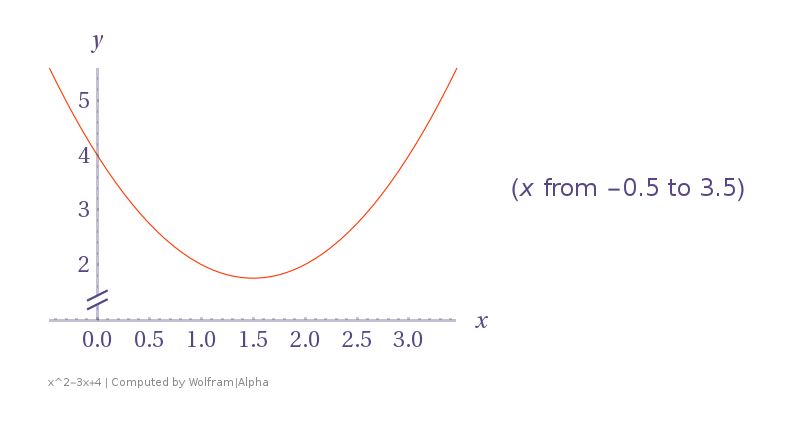The Dr. Loh method for finding quadratic roots#
Dr. Po-Shen Loh (Caltech, Princeton, Cambridge, Carnegie Mellon University) has developed a method for finding the roots of a quadratic equation without the need for factoring using guess-and-check or the tedious to remember and use quadratic equation. It is based upon known ideas, but has never before been expressed as a comprehensive algorithm. For reference, Dr. Loh’s website gives numerous examples going from simple to more difficult.
Real-world quadratics often pose a roadblock to students, wasting time and obscuring bigger picture efforts. I welcome this innovative approach. It will forever change the way this subject is taught in schools.
Note
The quadratic equation is now obsolete - although finding the discriminant \(b^{2} -4ac\) may still be useful for quickly determining the number of roots.

Simple example#
Here is how it works, in terms of a functioning algorithm you can use, not as a fully explained and justified method. For that see Dr. Loh's paper, published on December 19, 2019. Let's start backwards with known solutions -5 and -3 and create a quadratic to solve.
\((x+5)(x+3)\)
\(x^2+5x+3x+15\)
\(x^2+8x+15\)
Step one: take half the opposite of the middle term coefficient, plus and minus \(u\):
\(\frac{-8}{2} \pm u = -4 \pm u\)
Step two: set up an equation which creates a difference of two perfect squares, equal to the third term:
\(( -4+u)( -4-u)=15\)
\(16-u^2=15\)
Step three: solve for \(u\)
\(^2=16-15=1\)
\(u=\sqrt{1}=1\)
Step four: plug \(u\) back into the equation you created in step one
\(-4 \pm u\)
\(-4 \pm 1\)
\(-4+1=-3\)
\(-4-1=-5\)
These are the solutions.
Stepping it up#
But where the new method really shines is in circumstances where factoring is more difficult than it is in the above example. For instance:
\(3x^2-7x-13=0\)
In this example, the first term has a coefficient that we must eliminate via division
\(x^2-\frac{7}{3} x-\frac{13}{3}\)
Step one: take half the opposite of the middle term coefficient, plus and minus \(u\):
\(\frac{7}{3}\times\frac{1}{2}=\frac{7}{6} \pm u\)
Step two: set up an equation which creates a difference of two perfect squares, equal to the third term:
\(\left(\frac{7}{6}+u\right)\left(\frac{7}{6}-u\right) =-\frac{13}{3}\)
\(\frac{49}{36}-u^{2} =-\frac{13}{3}\)
Step three: solve for \(u\)
\(\frac{49}{36} -u^2 =-\frac{13}{3}\)
\(u^2 =\frac{49}{36} --\frac{13\times 12}{3\times 12}\)
\(u^2 =\frac{49}{36} +\frac{156}{36} =\frac{205}{36}\)
\(u=\sqrt{\frac{205}{36}} =\frac{\sqrt{205}}{6}\)
Step four: plug \(u\) back into the equation you created in step one
\(\frac{7}{6} \pm u\)
\(\frac{7}{6} \pm \frac{\sqrt{205}}{6}\)
\(\frac{7}{6}+\frac{\sqrt{205}}{6}\approx 3.55...\)
\(\frac{7}{6}-\frac{\sqrt{205}}{6}\approx -1.22...\)
Checking the solutions in Wolfram Alpha indicate they are correct
Wolfram Alpha plot{style="margin:0 auto;"}
Solutions in the complex plane#
The aspect of this method that really makes me excited, however, is dealing with quadratics which don't have real number solutions. This method has no limitations when finding solutions in the complex plane. For instance:
\(x^2-3x+4\)

Step one: take half the opposite of the middle term coefficient, plus and minus \(u\):
\(\frac{3}{2} \pm u\)
Step two: set up an equation which creates a difference of two perfect squares, equal to the third term:
\(\left(\frac{3}{2}+u\right)\left(\frac{3}{2}-u\right) =4\)
Step three: solve for \(u\)
\(\frac{9}{4} -u^2 =4\)
\(u^2 =\frac{9}{4} -\frac{4\times 4}{1\times 4}\)
\(u^2 =\frac{9}{4} -\frac{16}{4} =\frac{-7}{4}\)
\(u=\sqrt{\frac{-7}{4}} =\frac{\sqrt{-7}}2\)
We have the square root of a negative number, so we simplify it using \(i=\sqrt{-1}\)
\(u=\frac{i\sqrt{7}}{2}\)
Step four: plug \(u\) back into the equation you created in step one
\(\frac{3}{2} \pm u=\frac{3}{2} \pm \frac{i\sqrt{7}}{2}\)
\(\frac{3}{2}+\frac{i\sqrt{7}}{2}\approx 1.5+1.32i...\)
\(\frac{3}{2}-\frac{i\sqrt{7}}{2}\approx 1.5-1.32i...\)
Double checking with Wolfram Alpha we see that the solutions in the complex plane are correct
